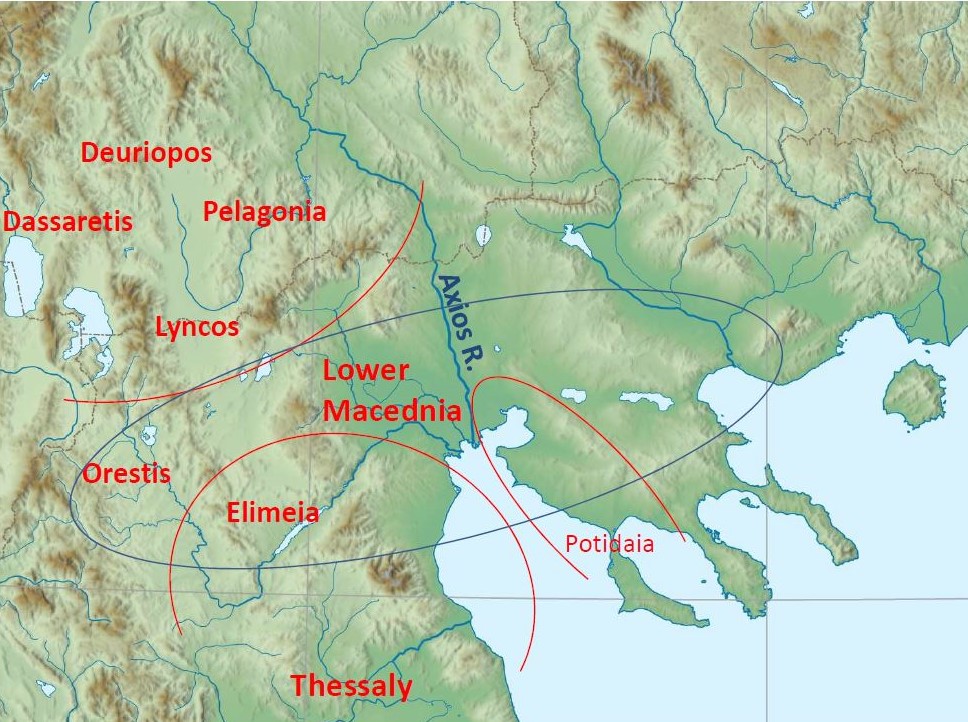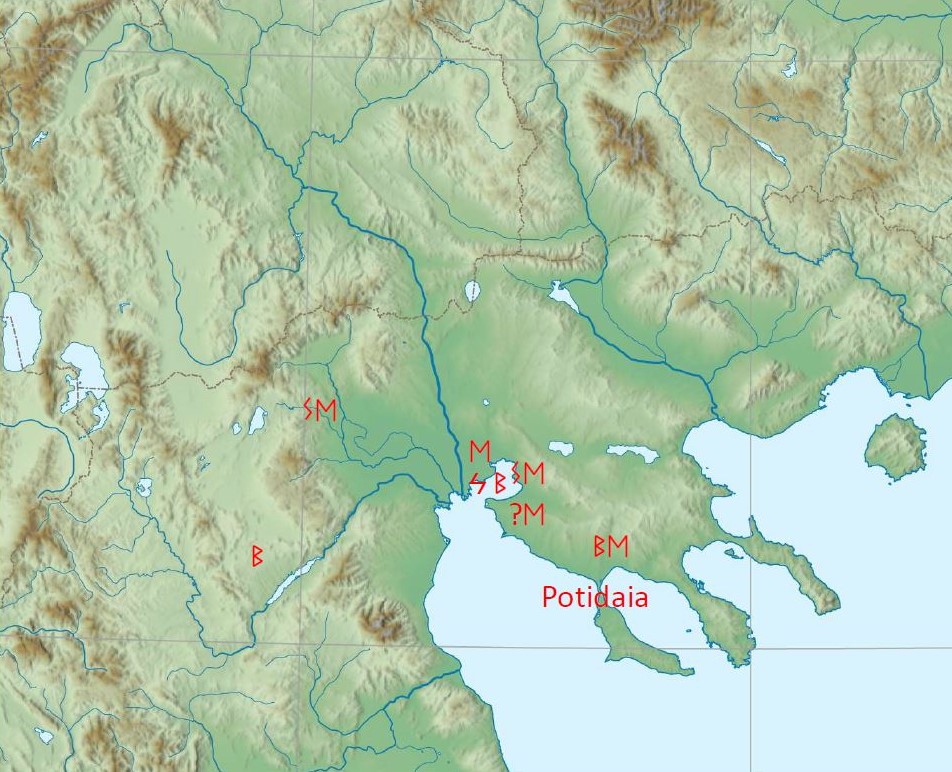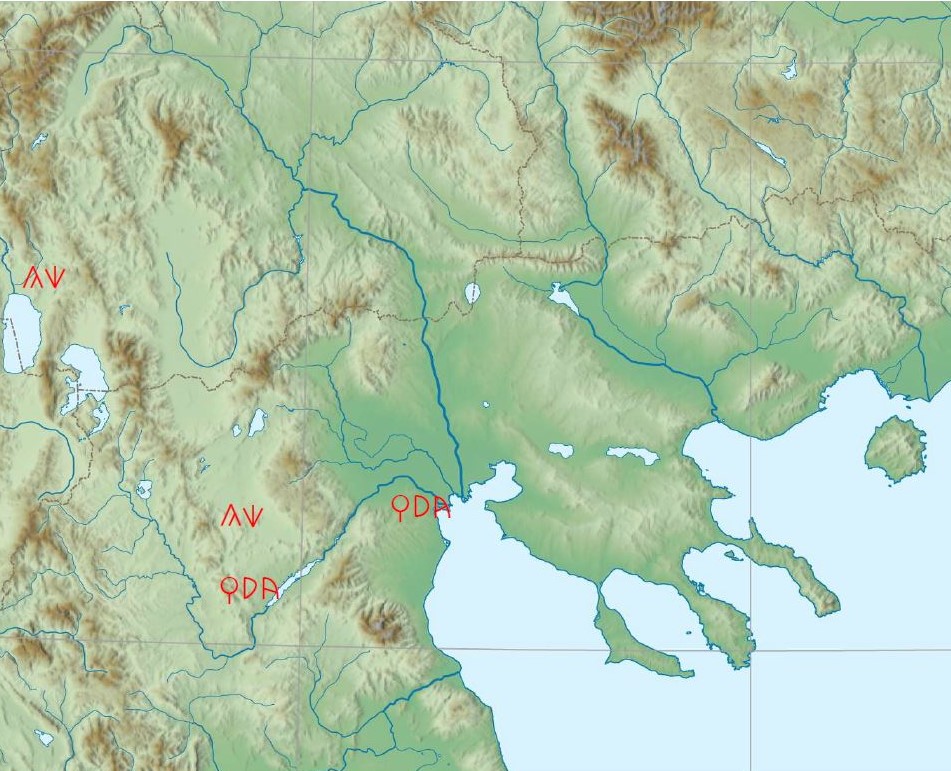Citation with persistent identifier: Boufalis, Angelos. “Local Scripts in Archaic Macedonia.” CHS Research Bulletin 7 (2019). http://nrs.harvard.edu/urn-3:hlnc.essay:BoufalisA.Local_Scripts_in_Archaic_Macedonia.2019
Up to the end of the fifth century BCE, when the Ionic alphabet was adopted by all Greeks as the common script, the Greek city-states used distinct local scripts, each one setting up its own local variation, produced either by re-designing the original forms or by inventing new, unique and distinctive ones. As Nino Luraghi (2010) has shown, the aim was to turn the script into a distinguishing element between states, and thus it functioned as an indication of independence for the state, of political identity for the citizens, and of origin for individuals away from their homeland.
In Northern Greece, unlike city-states, the kingdom(s) of Macedonia did not participate in the epigraphic habits that were developed in the Archaic period around the Aegean; however, Macedonia was not an illiterate country. Already in the sixth century BCE there are inscriptions on portable objects that may have been written locally, and in the fifth century BCE stone inscriptions appear in large inland settlements. In 1961, Lilian H. Jeffery in The Local Scripts of Archaic Greece, although having only numismatic evidence to work on, remarked the presence of different local scripts in the region of Northern Greece and further remarked that the kingdom of Macedonia eventually adopted a foreign local script, the Ionic, in official inscriptions (Jeffery 1961:364). Since then a considerable number of inscriptions and inscribed objects of the Archaic and Classical period has been unearthed, only to substantiate Jeffery’s remark (see, e.g., Panayotou 1996). Due to the lack of an epigraphic tradition, foreign local scripts were employed; geographical proximity, however, was not by itself a sufficient factor for the transmittance, and I thought it was worth investigating how this process evolved, which factors governed it, and whether or not script was employed as a demarcator of political independence for the autonomous kingdoms of Upper Macedonia, as was the case with city-states.
Thus, I collected all published epigraphic material down to ca. 400 BCE, I inventoried all distinctive letterforms, and I laid them out onto the map. I then evaluated the distribution patterns by taking into consideration the provenance of the letterforms, the chronology of the inscriptions, other archaeological evidence, and historical sources. Finally, I went on to map the regional spheres and areas of external influences in the wider Macedonian region highlighting the political geography of ancient Macedonia, and the cultural and trade links with external centers.
Each letter was examined as a distinct case study. Distribution maps were made for each one of the letters alpha, gamma, delta, epsilon, hêta, iôta, lambda, ksi, san, qoppa, rhô, sigma, chi, and omega, featuring one or more distinctive letterforms, the juxtaposition of which would presumably correspond to different spheres of influence or internal divisions within Macedonia.
Although the material is hardly sufficient to draw any definite conclusions, some distribution patterns did emerge, revealing the existence of distinct spheres of influence (Fig. 1).

The archaic local scripts appearing throughout Upper and Lower Macedonia were found to be generally in accordance with the historical sources that present the region to be divided in several autonomous political entities, as well as containing several formerly Thracian settlements, such as Therme (FGrHist 1 F146), and colonial city-states, such as Methone (Tzifopoulos 2012).
The geographical region that came to be Macedonia as we know it in the Late Classical period (Hammond 1995) was divided into several kingdoms, each with its own dynastic family, its own mythological genealogy, and apparently its own political agenda. The Central Macedonian plain and the coasts around the Thermaic Gulf comprised the kingdom of Lower (Herodotos 7.173.1; Thucydides 2.99.1) or “by the sea” (Thucydides 2.99.3) Macedonia, while in Upper Macedonia (Herodotos 7.173.4 and 8.137.1; Arrian Anabasis 1.2.5; Strabo 7.7.8) several ethnê (Hammond 2000), namely the Elimiotai, the Orestai, the Lyncestai, and the Pelagones, had formed small autonomous kingdoms, at times subdued and at times hostile to the kingdom of Lower Macedonia, constantly demonstrating their distinct ethnic and political identity through myths, coinage, and even war (Thucydides 2.99.2; Demosthenes Philippic 1 4; Hatzinikolaou 2009; Xydopoulos 2012).
Such political divisions are also reflected in the use of script. The colonies, not unexpectedly, used the local script of their metropolis, as they did with political institutions and cults. Thus, several local scripts of Southern and Eastern Greek city-states are present on the coast and in the immediate or even wider hinterland, as colonies did business with the neighboring states. The coastal area from Potidaia and up to the Axios River exhibits a relatively strong presence of Korinthian letterforms (Fig. 2) that always feature in graffiti in full Korinthian script and mostly on works of northern Peloponnesian metallurgy, attesting to the extent that Potidaia in the sixth century BCE dominated the trade in the Thermaic Gulf, and even possibly to the existence of northern Peloponnesian metallurgy workshops established in the area, as argued by Aliki Moustaka (2000) and further supported by Rastko Vasić (2010:38–39).

While there is Korinthian predominance in the eastern coast of the Thermaic Gulf, Ionic letter(form)s, especially hêta, ksi, the four-bar sigma, and omega, are widespread in large settlements on the western coast, especially Pella, Vergina, and Dion, where they feature on all stone inscriptions of the fifth century BCE. What is interesting is that the diffusion of Ionic letterforms matches that of Ionic works of sculpture (see Tiverios 2017:49; Fig. 3), which recalls the diffusion of Korinthian letterforms along with Korinthian metallurgy products, indicating that the diffusion of script in the Macedonian hinterland was inextricable with the penetration of foreign trade in the area of Northern Greece. However, this does not necessarily presuppose a decision to adopt the Ionic as the official script of the Macedonian kingdom by a central authority. Perhaps, too much significance has been attributed to the employment of the Ionic script in the legend on the coinage of Alexander I, which now has been dated to 465–454 BCE (Kagan 1987:24–25), after Alexander took control from the Bisaltians of a silver mine in the region of Mt. Pangaion. Alexander’s name does feature on his coinage in a clearly Ionic script (Babelon 1907:1077–1096; Head 1911:218–220; Gaebler 1935:148–153); however, the issues in his name are not essentially different in weight standard, style and dies from the other Thraco-macedonian coinage of the period, especially those of the Bisaltians, whose coinage, if uninscribed, is indistinguishable from that of Alexander. The Bisaltians employed the Ionic script in their later issues, abandoning the Parian/Thasian that they used in their earlier ones (Babelon 1907:1071–1078; Head 1911:199–200; Gaebler 1935:48–50). It is possible that Alexander simply ordered the change of the legend but continued coin production as before, without consideration about the letterforms the engraver would use. Furthermore, he may have had also taken over the connections to foreign markets. It is doubtful that these inscriptions were intended to be legible by locals; this heavy-weight coinage was destined to be exported to foreign markets, rather than be circulated through internal financial transactions. It is more likely that inscriptions on Thraco-macedonian coinage are borrowing the alphabet of the (main) trade partner, and that explains the shift from the Parian/Thasian to the Ionic script on the coinage of the Bisaltai, as well as a similar change on the coinage of Ichnai, an independent city on the lower Axios River, which displayed its ethnic using both the ‘red’ and the ‘blue’ chi (according to Kirchhoff’s 1877 map) in different issues (Babelon 1907:1103–1108, no. 1551: ‘red’ chi, no. 1553–1554: ‘blue’ chi; Head 1911:199), most likely going from the ‘red’, likely “taken from some Euboic source in Chalkidike” (Jeffery 1961:364), to the ‘blue’ one, at the same time shifting from the Phoenician to the Babylonian weight standard (Babelon 1907:1107), most probably reflecting a turn in international trade. As the use of the Ionic script was the rule for all early fifth century BCE coinage of the Thracian tribes (Babelon 1907:1032–1076, and 1133–1126; Head 1911:194–202; Gaebler 1935:48–50, 55–57, 63–72, 80–92, and 144–148), it is impossible to ascertain whether or not Alexander made a conscious choice concerning the letterforms used on his own issues, and by extension in any other inscription in Macedonia. The employment of the Ionic script, both in graffiti and stone inscriptions, none of which is public, may have actually been due to the actual presence of Ionians, either professionals (traders, stonecutters) or simply migrants, settled in Macedonia (Thucydides 4.124.1; Hatzopoulos 1996:106–107), rather than a royal ruling.

Beyond the Thermaic Gulf, the clearest evidence for external influence is the presence of Thessalian forms of the letters alpha, delta, and chi (on the forms see Doulgeri-Intzesiloglou 2000; Fig. 4), which are limited in the south, in Elimeia, as well as in Pieria, where they appear to be predominant in the archaic period, but compete with Ionic ones in the fifth century BCE. In Elimeia, Ionic forms were apparently considered innovative graphemes, useful to distinguish sounds further, and were adopted to supplement the Thessalian script, thus producing graffiti inscriptions of a mixed character in the fifth century BCE; in Pieria, on the contrary, the Ionic script, when employed, was fully adopted and especially stone inscriptions were written exclusively in Ionic, as is the case in all other regions from the fifth century BCE onwards.

It seems, therefore, that just like in Southern Greece, the script was a distinguishing element between states. Elimeia and Lyncos, kingdoms that are known to have been antagonistic, and even hostile towards the kingdom of Lower Macedonia, exhibit rather closer epigraphic affinity to other neighboring states: Elimeia has stronger links to Thessaly, and Lyncos has not produced (as yet) any early inscriptions, just like the wider region to the northwest, in and around Illyria, toward which Lyncos may have been leaning politically and economically. Orestis, on the contrary, was apparently better integrated in the cultural and trade networks of the kingdom of Lower Macedonia. The kingdom of Lower Macedonia and the autonomous kingdoms of Upper Macedonia seem to have been making individually their own political and trade associations, through which a number of distinct letterforms from several local Greek alphabets were introduced into Macedonia, while in the coastal cities different Greek alphabets co-existed and intermingled with each other pointing also to the existence of multicultural communities.
Works Cited
Babelon, E. 1907. Traité des monnaies grecques et romaines. Part 2, Description historique. Vol. 1, Comprenant les monnaies grecques depuis les origines jusqu’aux guerres médiques. Paris.
Doulgeri-Intzesiloglou, A. 2000. Θεσσαλικές επιγραφές σε τοπικό αλφάβητο. Unpublished PhD diss., Aristotle University of Thessaloniki.
Gaebler, H. 1935. Die antiken Münzen Nord–Griechenlands. Vol. III, Die antiken Münzen von Makedonia und Paionia, Zweite Abteilung. Berlin.
Hammond, N. G. L. 1995. “Connotations of ‘Macedonia’ and of ‘Macedones’ until 323 B.C.” Classical Quarterly 45:120–128.
———. 2000. “The Ethne in Epirus and Upper Macedonia.” The Annual of the British School at Athens 95:345–352.
Hatzinikolaou, Κ. 2009. “Συμβολή στη μελέτη της ιστορικής γεωγραφίας της Άνω Μακεδονίας.” Μακεδονικά 38:1–20.
Hatzopoulos, M. B. 1996. Macedonian institutions under the kings. Vol. I, A Historical and Epigraphic Study. Μελετήματα 22. Athens.
Head, B. V. 1911. Historia Numorum: A Manual of Greek Numismatics. 2nd ed. Oxford.
Jeffery, L. H. 1961. The Local Scripts of Archaic Greece: A Study of the Origin of the Greek Alphabet and its Development from the Eighth to the Fifth Century B.C. Oxford.
Kagan, J. H. 1987. “The Decadrachm Hoard: Chronology and Consequences.” In Coinage and Administration in the Athenian and Persian Empires, ed. I. Carradice, 21–28. British Archaeological Reports, International Series, 343. Oxford.
Kirchhoff, A. 1877. Studien zur Geschichte des griechischen Alphabets. Berlin.
Luraghi, N. 2010. “The Local Scripts from Nature to Culture.” Classical Antiquity 29:68–91.
Moustaka, A. 2000. “Πελοπόννησος και Μακεδονία: Παρατηρήσεις στα λεγόμενα κράνη Ιλλυρικού τύπου.” In Μύρτος: Μνήμη Ιουλίας Βοκοτοπούλου, ed. P. Adam-Veleni, 393–410. Thessaloniki.
Panayotou, A. 1996. “Dialectal Inscriptions from Chalcidice, Macedonia, and Amphipolis.” In Inscriptions of Macedonia. Third International Symposium on Macedonia, Thessaloniki, 8–12 Δεκεμβρίου 1993, ed. E. Voutiras, 124–163. Thessaloniki.
Tiverios, M. 2017. “Εποχή του Σιδήρου (1050-480 π.Χ.).” In Αρχαιολογία: Μακεδονία και Θράκη, ed. A. G. Vlachopoulos, and D. Tsiafaki. Athens.
Tzifopoulos, Y. Z. 2012. “Ιστορικό διάγραμμα Μεθώνης.” In Μεθώνη Πιερίας Ι: Επιγραφές, χαράγματα και εμπορικά σύμβολα στη γεωμετρική και αρχαϊκή κεραμική από το ‘Υπόγειο’ της Μεθώνης Πιερίας στη Μακεδονία, ed. M. Bessios, Y. Z. Tzifopoulos, and A. Kotsonas, 15–40. Thessaloniki.
Xydopoulos, I. K. 2012. “Upper Macedonia.” In Threpteria: Studies on Ancient Macedonia, ed. Μ. Tiverios, P. Nigdelis, and P. Adam-Veleni, 520–539. Thessaloniki.
Vasić, R. 2010. “Reflecting on Illyrian Helmets.” Starinar, n.s., 60:37–55.
